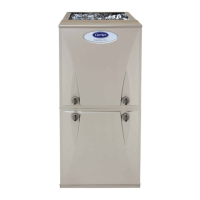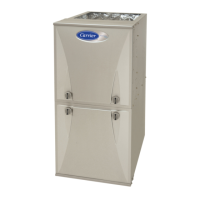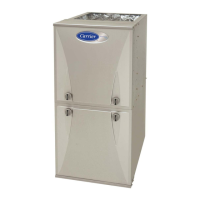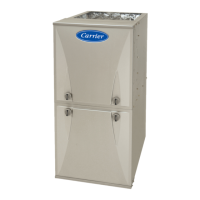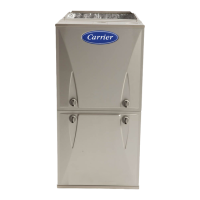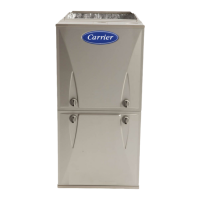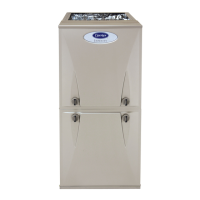ii
VENTING
Furnace is set in place in the required orientation.
Special Venting Requirements for Installations in
Canada
Installation in Canada must conform to the requirements of
CAN/CSA B149 code. Vent systems must be composed of pipe,
fittings, cements, and primers listed to ULC $636. The special
vent fittings and accessot T concentric vent termination kits and
accessot T external drain trap have been certified to ULC $636 for
use with those Royal Pipe and IPEX PVC vent components which
have been certified to this standard. In Canada, the primer and
cement must be of the same manufacturer as the vent system
GVS-65 Primer (Pm_le) for Royal Pipe or IPEX System 636,
PVC/CPVC Primer, Pm_le Violet for Flue Gas Venting and
GVS-65 PVC Solvent Cement for Royal Pipe or IPEX System
636(1)t, PVC Cement for Flue Gas Venting, rated Class IIA, 65 deg
C. must be used with this venting system - do not mix primers and
cements from one manufacturer with a vent system from a different
manufacturer. Follow the manufacturer's instructions in the use of
primer and cement and never use primer or cement beyond its
expiration date.
The safe operation, as defined by ULC $636, of the vent system is
based on following these installation instructions, the vent system
manufacturer's installation instructions, and proper use of primer
and cement. All fire stop and roof flashing used with this system
must be UL listed material. Acceptability under Canadian standard
CAN/CSA B149 is dependent upon full compliance with all
installation instructions. Under this standard, it is recommended
that the vent system be checked once a year by qualified service
personnel.
The authority having jurisdiction (gas inspection authority,
municipal building department, fire department, etc) should be
consulted before installation to determine the need to obtain a
permit.
*IPEX System 636T'_isa trademark of IPEXInc.
Consignes sp6ciales pour l'installation de
ventilation au Canada
L'installation faite au Canada doit se conformer aux exigences du
code CAN/CSA B149-2010. Ce syst_me de ventillation doit se
composer de tuyaux, raccords, ciments et appr_ts conformes au
ULC $636. La tuyauterie de ventillation des gaz, ses accessoires,
le terminal concentrique mural ainsi que l'ensemble du drain de
condensat extdrieur ont _td certifids ULCS 636 pour l'application
des composantes Royal Pipe, IPEX PVC qui sont certifides 5. ce
standard. Au Canada, l'appr_t et le ciment doivent _tre du m_me
fabricant que le syst_me d'@acuation. L'appr_t GVS-65 (Purple) et
le ciment-solvant GVS-65 doivent _tre utilis6 avec les Royal Pipe.
Syst_me IPEX 636, appr_t PVC/CPVC, Purple pour @acuation
des gaz de combustion et syst_me IPEX 636(1)t, ciment PVC pour
@acuation des gaz de combustion, cord classe IIA, 65 deg C.
doivent _tre utilis6s avec le syst_me d'@acuation IPEX 636 - Ne
pas combiner 1 'appr_t et le ciment d'un manufacturier avec un
syst_me d'@acuation d'un manufacturier different.
Bien suivre les indications du manufacturier lors de l'utilisation de
l'apprat et du ciment et ne pas utiliser ceux-ci si la date d'expiration
est atteinte.
L'opdration sdcuritaire, tel que ddfinit par ULC $636, du systame
de ventilation est basd sur les instructions d'installation suivantes,
ainsi que l'usage approprid de l'apprat et ciment. Tout arrat feu et
solin de toit utilisds avec ce systame doivent atre des matdriaux
listds UL. L'acceptation du standard Canadien CAN/CSA B149
est directement relid fi l'installation conforme aux instructions ci-
haut mentionndes. Le standard Canadien recommande 1' inspection
par un personnel qualifid et ce, une fois par annde.
Les autoritd es ayant juridiction (inspecteurs de gas, inspecteurs en
bfitiments, d@artement des incendies, etc) devraient _tre consultdes
avant l'installation afin de d_terminer si un permis est requis.
CARBON MONOXIDE POISONING HAZARD
Failure to follow the steps outlined below for each appliance
connected to the venting system being placed into operation
could result in carbon monoxide poisoning or death.
The following steps shall be followed for each appliance
connected to the venting system being placed into operation,
while all other appliances connected to the venting system are
not in operation:
1. Seal any unused openings in venting system.
2. Inspect the venting system for proper size and
horizontal pitch, as required in the National Fuel Gas
Code, NFPA 54/ANSI Z223.1-2009 and these
instructions. In Canada, refer to CAN/CSA-
B149.1-2010. Determine that there is no blockage or
restriction, leakage, corrosion and other defciencies,
which could cause an unsafe condition.
3. As far as practical, close all building doors and
windows and all doors between the space in which the
appliance(s) connected to the venting system are
located and other spaces of the building.
4. Close fireplace dampers.
5. Turn on clothes dryers and any appliance not
connected to the venting system. Turn on any exhaust
fans, such as range hoods and bathroom exhausts, so
they are operating at maximum speed. Do not operate
a summer exhaust fan.
6. Follow the lighting instructions. Place the appliance
being inspected into operation. Adjust the thermostat
so appliance is operating continuously.
7. Test for spillage from draft hood equipped appliances
at the draft hood relief opening after 5 minutes of
main burner operation. Use the flame of a match or
candle.
8. If improper venting is observed during any of the
above tests, the venting system must be corrected in
accordance with the National Fuel Gas Code, NFPA
54/ANSI Z223.1-2009. In Canada, refer to CAN/
CSA-BI49.1-2010.
9. After it has been determined that each appliance
connected to the venting system properly vents when
tested as outlined above, return doors, windows,
exhaust fans, fireplace dampers and any other
gas-fired burning appliance to their previous
conditions of use.
General
If this furnace replaces a furnace that was connected to a vent
system or chimney, the vent or vent connectors of other remaining
appliances may need to be re-sized. Vent systems or vent
connectors of other appliances must be sized to the minimum size
as determined using appropriate table found in the current edition
of National Fuel Gas Code NFPA 54/ANSI Z-223.1. In Canada,
refer to CAN/CSA-BI49.1.
An abandoned masonry chimney may be used as a raceway for
properly insulated and supported combustion-air (when
applicable) and vent pipes. Each furnace must have its own set of
combustion-air and vent pipes and be terminated individually, as
shown in Fig. 47 for Direct Vent (2-Pipe) system or Fig. 48 for
ventilated combustion air option.
40

